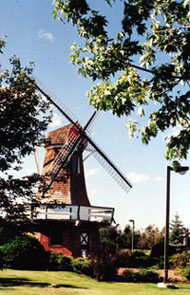



AMONG THE THOUSANDS of U.E. Loyalists who arrived in British North America at the conclusion of the American Revolution were a large number of Dutch colonists who chose not to side with the revolutionary forces of George Washington. It was not until the late nineteenth century, however, that the Dutch once again migrated to Canada, this time as agricultural homesteaders flooding the prairie provinces where they assistedin opening up the “last best west.” Still another wave of Dutch farmers came to Canada during the interwar period,mostly settling in rural Ontario where they helped secure the agricultural base of the province as trailblazers for market gardening and sugar beet and tobacco farming that would grow extensively in the following decades. During this time Dutch farmers significantly contributed to the development of the Holland Marsh, north of Toronto, into one of the largest and most productive vegetable growing centres in Canada.
The postwar fifties and sixties witnessed a great surge in the growth of Dutch immigration to Canada. The Second World War saw Canada forge an important bond with The Netherlands when it became a safe haven for Crown Princess Juliana of The Netherlands and her family and when Canadian soldiers played a pivotal role in the liberation of The Netherlands from Nazi occupation. After the war, Canada looked with great favour upon The Netherlands, ready to welcome the immigration of thousands of Dutch nationals – war brides of Canadian servicemen and a badly needed agricultural work force. By the mid-1950s, the Canadian government saw fit to issue a clarion call for Dutch skilled industrial workers, technicians, business people, and professionals. According to the 1996 census, 916,215 Canadians of Dutch origin lived in Canada. Ontario was home to nearly half of the Dutch Canadians. Only 18,665 were residents of Quebec. British Columbia topped the list in the West with 176,235, followed by Alberta with 136,835, Manitoba with 51,595, and Saskatchewan with 35,305. In the Maritimes, 41,475 lived in Nova Scotia and 14,650 in New Brunswick. Among cities, Toronto was the leading settlement area with 44,040, followed by Vancouver with 33,095. Other main centres of Dutch settlement in Ontario include Ottawa-Hull, Hamilton, St. Catharines-Niagara, Kitchener, and Oshawa. Sizable numbers can also be found in Edmonton, Calgary, Winnipeg, Montreal, and Halifax. There are also settlers from the northern province of Friesland in the Netherlands. Frisians numbering approximately 10,000 in Canada today choose to identify themselves as a subset of the important Dutch-Canadian community.
Dutch women have played an indispensable role in the economic life of the ethnie. Single women who migrated to Canada for economic betterment filled the insatiable demand for domestic servants. These women profited from sharing the ethnicity of the dominant groups in the population. The Dutch were secure in the support of their ethnic community and in their high reputation among employers. The women could move in and out of domestic service in accordance with its advantages and disadvantages. Marriage and a family thrust new responsibilities on the women: shopping, cooking, laundering, knitting, sewing clothing, caring for the children, and, commonly, managing the family purse. Women also contributed to the family economy initially through work on the farm and in the fields. By the 1950s, Dutch women could be found on factory assembly lines. Education of their daughters in the 1960s and 1970s eased entry into the technical and professional worlds.
Postwar immigrants showed remarkable initiative in the creation of group clubs and community associations established to provide cultural, educational, social, and sports activities for the Dutch community. The community also dutifully supported dance and chorale groups, Dutch-language print and broadcast media. Additionally, the community spearheaded the establishment of co-operative savings and group lending institutions, providing badly needed economic aid and capital in the face of unsympathetic Canadian bankers. Of note, the DUCA Community Credit Union of Toronto (founded 1954) began as an immigrant mutual benefit society only to become a multi-faceted computerized financial services organization offering its members retirement plans, foreign currency transactions, personal and mortgage loans.
Immigrants from the Netherlands have enriched the political, intellectual, athletic, and cultural life of Canada, often applying their religious values to their adopted country’s cultural life. Dutch Canadians serve on municipal and provincial boards and in various capacities in both the provincial and federal governments. Educator Egerton Ryerson (Ryersoon), of Loyalist descent, solidly laid the foundations for Ontario’s educational system while serving as Chief Superintendent of Education for the province from 1844 to 1876. The arts in Canada have been enhanced by painter Cornelius Krieghoff (1815-72) and a number of sculptors, designers, weavers, pottery makers, and craftspeople working in stained glass, mosaics, and jewellery. Canadians of Dutch origin have also brought honour to Canada as figure skaters – Petra Burka won the Canadian, North American, and Women’s World Figure Skating Championships in 1965; as car racers – Eppie Wietzes earned considerable recognition for his awesome driving skills and unquenchable thirst for speed; and as filmmakers – Patricia Rozema’s recent adaption of Jane Austen’s Mansfield Park (1999) received international acclaim.